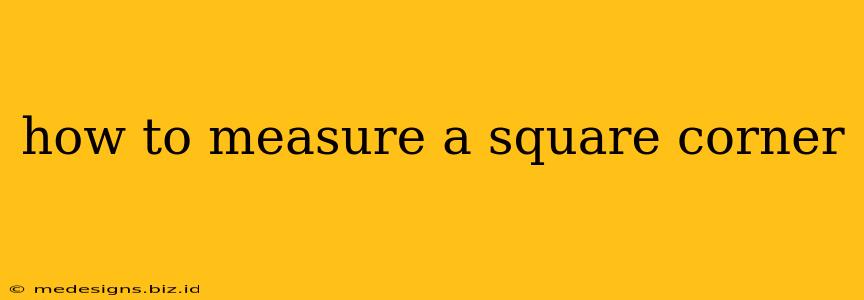Creating perfectly square corners is crucial for numerous tasks, from building a deck to framing a picture. Whether you're a seasoned DIY enthusiast or a complete beginner, understanding how to accurately measure a square corner is essential for achieving professional-looking results. This guide will explore various methods, from simple tools to more advanced techniques, ensuring you can confidently tackle any project requiring precise angles.
Understanding Square Corners and Their Importance
A square corner, also known as a right angle, measures exactly 90 degrees. Achieving this precision is critical because even slight inaccuracies can lead to significant problems down the line. In construction, an imperfect corner can result in unstable structures, misaligned walls, and ultimately, a flawed project. In woodworking, it affects the fit and finish, impacting both aesthetics and functionality.
Simple Methods for Measuring Square Corners
Before diving into specialized tools, let's explore the basic methods anyone can use:
1. Using a Carpenter's Square: The Classic Approach
The carpenter's square is the quintessential tool for checking squareness. Its simple design – a long arm and a short arm meeting at a 90-degree angle – makes it perfect for quick and easy verification. Simply align the square's arms against the corner you're checking. If the arms align perfectly with both sides, your corner is square.
Pros: Inexpensive, readily available, easy to use. Cons: Limited accuracy for large dimensions; can be difficult to use in tight spaces.
2. The 3-4-5 Triangle Method: Ancient Wisdom for Modern Projects
This method utilizes the Pythagorean theorem. Create a right-angled triangle where one leg measures 3 units, another leg measures 4 units, and the hypotenuse measures 5 units. These measurements, regardless of the unit used (inches, centimeters, etc.), will always form a perfect right angle. Measure 3 units along one side of the corner, 4 units along the other side, and measure the distance between those points. If the distance is exactly 5 units, your corner is square.
Pros: Requires only a measuring tape, works for larger dimensions. Cons: Requires careful measurement to maintain accuracy; slight errors can throw off results.
Advanced Techniques for Precise Square Corner Measurement
For those demanding absolute precision, these more advanced techniques prove invaluable:
1. Using a Digital Angle Finder: Technology at Your Fingertips
Digital angle finders offer highly accurate measurements. Simply place the tool against the corner, and the digital display provides the exact angle. This eliminates guesswork and provides a clear indication of the corner's squareness.
Pros: High accuracy, easy-to-read digital display. Cons: Can be more expensive than simpler tools.
2. Employing a Speed Square: Versatility for Various Applications
A speed square is a multi-purpose tool that combines a carpenter's square with other functions. It enables you to check squareness, mark angles, and even make precise cuts. This tool's versatility makes it a valuable asset for any DIY project.
Pros: Versatile, combines multiple functions into one compact tool. Cons: Can be a bit complex for beginners to master.
Troubleshooting and Tips for Achieving Perfect Square Corners
- Double-check your measurements: Always verify your measurements multiple times to minimize errors.
- Use appropriate units: Stick consistently to one unit of measurement (inches or centimeters) to avoid confusion.
- Consider material thickness: When working with materials of significant thickness, account for that thickness in your measurements.
- Adjust as needed: If you find an imperfection, make the necessary adjustments before proceeding to avoid problems later.
By following these methods and tips, you can accurately measure square corners and ensure your projects are built to last. Remember, precision is key to success in any construction or woodworking endeavor. Choosing the right method depends on your project's complexity and the level of accuracy required.
